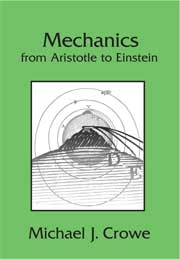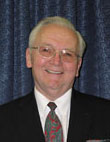Mechanics from Aristotle to Einstein
by Michael J. Crowe
7" x 10", 352 pages, bibliography, index.
Publication date, July 2007.
For pricing and ordering information, see the ordering section below.
 In this book, Michael Crowe does for the physics of moving bodies what he had previously done for theories of the universe (in his highly regarded Theories of the World from Antiquity to the Copernican Revolution and Modern Theories of the Universe from Herschel to Hubble). In a remarkably concise compass, Crowe presents, through actual examples, the fascinating story of how philosophers and scientists through the ages have tried to understand how things move. Included are substantial selections from the writings of Aristotle, Oresme, Descartes, Galileo, Huygens, Newton, and Einstein. The selections are furnished with extensive notes aimed at guiding nonspecialist readers through the texts. Introductory sections provide historical information that helps us understand and appreciate each chapter in the story, which Crowe aptly characterizes as "the most remarkable story in all secular history."
In this book, Michael Crowe does for the physics of moving bodies what he had previously done for theories of the universe (in his highly regarded Theories of the World from Antiquity to the Copernican Revolution and Modern Theories of the Universe from Herschel to Hubble). In a remarkably concise compass, Crowe presents, through actual examples, the fascinating story of how philosophers and scientists through the ages have tried to understand how things move. Included are substantial selections from the writings of Aristotle, Oresme, Descartes, Galileo, Huygens, Newton, and Einstein. The selections are furnished with extensive notes aimed at guiding nonspecialist readers through the texts. Introductory sections provide historical information that helps us understand and appreciate each chapter in the story, which Crowe aptly characterizes as "the most remarkable story in all secular history."
At the same time, Mechanics from Aristotle to Einstein is itself an intoduction to the foundations of mechanics. Ideas that were originally expressed in unfamiliar language are restated using modern terminology and simple algebra to make them comprehensible to present-day readers. Examples and problems are provided to give a true "hands on" experience of these ideas and discoveries, which are fundamental to an understanding of both our physical universe and our civilization itself.
Features
- Selected as "Outstanding Academic Title" by Choice, January 2009.
- Includes selections from the writings of Aristotle, Oresme, Descartes, Galileo, Huygens, Newton, and Einstein.
- Includes historical information and extensive notes.
- Includes examples and problems.
Reviews
This wonderful, user-friendly book combines selected translations of original texts, extensive commentary, numerical examples of computations, biographical notes, and easy lab experiments to provide a history of mechanics, emphasizing motion (i.e., dynamics). Crowe (emer., Univ. of Notre Dame) is a well-recognized scholar on the history of science, and he developed the book from long experience in teaching. ... Selections on Galileo and Newton, about 60 percent of the book, are superb... Crowe's book is incomparable because of the perfect balance of translations, examples, computations, commentary, and hands-on exercises..
— J. Lambropoulos
Choice, March 2008
The gradual unraveling of the mystery of motion makes as fascinating a story as the Copernical revolution or the rise of the theory of evolution. ... Three different sorts of readers are addressed in Mechanics from Aristotle to Einstein: undergraduates in liberal studies programs who have little or no knowledge of physics, graduate students in history of science, and general readers. After an introductory chapter, mainly on Aristotle and Nicole Oresme, the book consists of excerpts from Galileo, Newton, and Einstein, accompanied by introductions and commentaries and bridged by short chapters on intermediate figures (including excerpts from Descartes and Huygens).
— W. R. Laird
Isis, 2008
(Isis is the journal of the History of Science Society, published by the University of Chicago Press).
The present book consists of a thoroughly commented source book on the history of mechanics starting with Aristotle and ending in Einstein's theory of relativity. It is ideally suited for courses in which students can read excerpts of original texts translated into English which are explained and put into the historical context by the author. Central themes are early mechanics (before Galilei), Galilei, Newton, and Einstein and the text can well be understood as a history of the meaning of relativity through the centuries. ... The book is very well written and can be read even by beginners in the field.
— Thomas Sonar
Zentralblatt für Mathematik, 2009
As a text, it is a good standard text dealing mostly with early modern physics (mechanics), with some background on Aristotle and an end section on Einstein's special and general relativity. Crowe's commentary ... is clear and for the most part admirable. ... With such an admirably clear commentary, [quibbles with certain interpretative claims] would be mere cavils.
Finally, it is of note that the book is excellently produced. Green Lion Press ... continue to publish books of outstanding quality.
— Peter Machamer
Aestimatio, 2008
From Crowe's Preface to Mechanics from Aristotle to Einstein
It is my conviction that the story of the development of mechanics from Galileo to Einstein’s special theory of relativity is the most remarkable story in all secular history. The famous philosopher Alfred North Whitehead writing in his Science and the Modern World about only the Galileo through Newton portion of the story, suggested one reason why the story seems so noteworthy.
"This subject of the formation of the three laws of motion and of the law of gravitation deserves critical attention. The whole development of thought occupied exactly two generations. It commenced with Galileo and ended with Newton's Principia; and Newton was born in the year that Galileo died. Also the lives of Descartes and Huygens fell within the period occupied by these great terminal figures. The issue of the combined labors of these four men has some right to be considered as the greatest single intellectual success which mankind has achieved."
Strong as Whitehead’s claim is, it is less bold than a quite comparable claim made by the eminent historian Sir Herbert Butterfield, referring to that period, the scientific revolution, in which the developments to be recounted in the first two-thirds of this volume form the core. What Butterfield stated was:
" Since [the scientific revolution] overturned the authority in science not only of the middle ages but of the ancient world—since it ended not only in the collapse of scholastic philosophy but in the destruction of Aristotelian physics—it outshines everything since the rise of Christianity and reduces the Renaissance and Reformation to the rank of mere episodes, mere internal displacements, within the system of medieval Christendom. Since it changed the character of man’s habitual mental operations even in the conduct of the non-material sciences while transforming the whole diagram of the physical universe and the very texture of human life itself, it looms so large as the real origin both of the modern world and of the modern mentality that our customary periodisation of European history has become an anachronism and an encumbrance."
Even were one to reject Whitehead’s claim that this is humanity’s “greatest single intellectual success,” it is difficult to deny that this story can boast a cast of main characters that includes some of the most remarkable geniuses who have ever lived: Aristotle, Galileo, Descartes, Newton, and Einstein. Moreover, the materials that follow focus on precisely those achievements that made Galileo, Newton, and Einstein so famous. Although each of these three authors showed genius in many areas, it was what they contributed to mechanics that above all merited their immortality.
Authors of detective or mystery fiction might well envy the historian recounting this tale. Clues are literally spread throughout the universe, from the roll of a child’s ball to the revolution of a giant planet, from the flight of a toy balloon to the fall of a giant tree, from the toss of a tennis ball to the trajectory of a massive cannon shell. Numberless as the clues are, omnipresent as they may be, they proved to be so difficult to decipher, so elusive in their significance, that the keenest minds missed their meaning for centuries.
Moreover, the story has an extraordinary denouement. All the various lines of development leading up to the final resolution come together in a manner that is simultaneously exceptionally surprising yet also so remarkably perfect that it commands assent. It is difficult to think of any volume, fictive or factual, that culminates in a more delightful or dramatic denouement. Actually this understates the claim that can be made, for, as we shall see, a double denouement awaits us. First, we shall see Newton reveal a pattern that seems so perfect and so all encompassing that one can scarcely believe that hidden just beneath the surface of the picture painted by Newton lay a still more extraordinary and more convincing configuration, which was eventually brought forth by a man in his mid-twenties, Albert Einstein.
About the Author
 Michael J. Crowe is Cavanaugh Professor Emeritus in the Program of Liberal Studies at the University of Notre Dame. Mechanics from Aristotle to Einstein was developed and refined over many years of teaching undergraduates, both within and outside the Program. Crowe's present scholarly interests include an ongoing study of the question of extraterrestrial life.
Michael J. Crowe is Cavanaugh Professor Emeritus in the Program of Liberal Studies at the University of Notre Dame. Mechanics from Aristotle to Einstein was developed and refined over many years of teaching undergraduates, both within and outside the Program. Crowe's present scholarly interests include an ongoing study of the question of extraterrestrial life.
